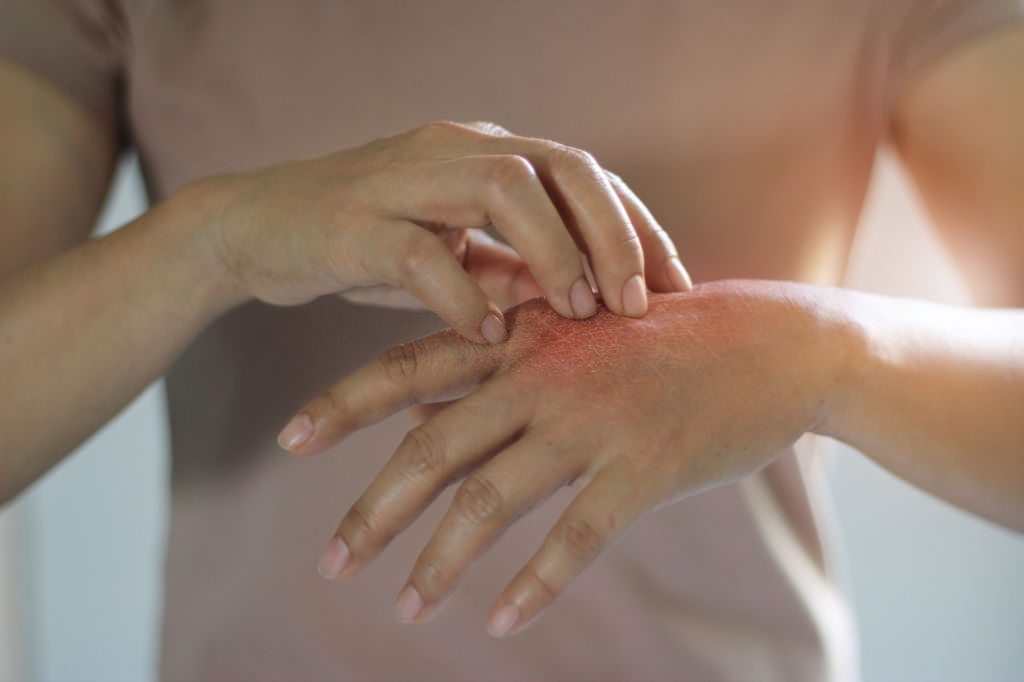What is Eczema?
If you suffer from chronic itchiness, redness, and inflammation of the skin then you are amongst the 31 million Americans affected by a skin condition known as Eczema. Also called Atopic Dermatitis, it is a chronic inflammatory skin condition characterized by periodic flare-up episodes. The symptoms of the condition are caused due to an immune response to a foreign or in-body allergen or trigger. More common in children than in adults, it can develop at any age. From childhood through adolescence to maturity, it can be moderate to severe with relapsing episodic occurrences.
There are 7 different kinds of eczema:
- Atopic dermatitis (most common)
- Contact dermatitis
- Neurodermatitis
- Dyshidrotic eczema
- Nummular eczema
- Seborrheic dermatitis
- Stasis dermatitis
What are the Symptoms of Atopic Dermatitis?
The hallmark symptom of the condition is itching (pruritus). The irritating, incessant urge to scratch the red, scaly rashes is caused by persisting inflammatory overreactions in the body. The severity can vary from person to person, sometimes being unbearable to the extent that the person suffering from Atopic Dermatitis, scratches till the crusted rash bleeds. This vicious sequence is known as the “itch-scratch cycle”
It is characterized by abnormally dry skin (xerosis), redness (erythema), thickened leathery patches (lichenification), small raised bumps that may weep clear liquid, and an intense urge to scratch that worsens at night (excoriation). Excessive scratching leads to bleeding open sores that present as an open wound, susceptible to infections caused by bacteria, fungi, or viruses. In addition, there may be creasing around the palms of the hands, forearms, wrists, and thickening of the skin around the eye area.
Condition of Atopic Dermatitis.
Atopic dermatitis can appear red in people with light skin, whereas people of color may be more prone to a grayish, darker brown, or purple presentation of the disease. These dark patches tend to persist even after the symptoms subside and are known as hyperpigmentation. In addition, African American people are known to have more severe manifestations of Atopic Dermatitis as compared to their lighter-skinned counterparts.
What Causes Atopic Dermatitis?
The precise cause for the complex inflammatory phenomenon remains unknown but it has been associated with a combination of elements as observed by researchers. It is a multifactorial condition related primarily to genetic susceptibility. It weakens the barrier function of the skin, making it prone to potential itching-related mechanical damage. Hence, genetics play an integral role in the probability of developing progressive Atopic Dermatitis. Other genetics-related consequences include increased trans-epidermal water loss, altered pH levels and dehydration, all of which predispose to Atopic Dermatitis.
Immunological factors:
Secondly, immunological factors causing an abnormal cell-mediated response are deemed responsible for the intolerable symptoms of AD. The imbalance of cytokines results in disruptions that cause an overreaction of the immune response triggering uncontrollable pruritus and inevitable scratching.
Environmental factors:
Furthermore, Environmental factors add monumentally to the worsening and maybe even the initiation of the condition. Exposure to chemicals such as harsh detergents, airborne formaldehydes, artificial scents, and preservatives may initiate symptoms of Atopic Dermatitis. These chemicals alter the pH of the skin hence impeding enzyme activity that inevitably triggers an inflammatory response. An allergen or trigger may set off the body’s immune response into an exaggerated frenzy. One person’s triggers may vary vastly from another person’s, there is no known specificity of patterns.
Symptoms may be elicited at any random time of the year on different areas of the body. There are several exogenous factors responsible for eczema-related symptoms that include soaps and skincare; fabrics like wool; pollen or mold; changes in temperature and humidity; tobacco smoke, and excessive UV light exposure. Endogenous factors are inclusive of varying stress levels and aggression; skin infections, hormonal imbalance, and food-related allergies.
The Aftermath: Let’s Talk About the Complications
This multifaceted disorder is not devoid of complications. The chronology of the cause and effect of some of these parallel comorbidities seems to be vague. Hence, this has kept Clinical Research Organization in the USA from elucidating the specific cause of Atopic Dermatitis.
Complications of Atopic Dermatitis:
Asthma and Hay fever are the most common complications of Atopic Dermatitis. A child suffering from eczema will have a greater possibility of developing asthma as compared to a child without the inflammatory disorder in their early childhood.
Furthermore, a skin condition is known as neurodermatitis (lichen simplex chronicus) characterized by a persisting itchy rash that may develop as an impediment. This chronic situation eventually changes the skin texture leaving it thicker, pigmented, and leathery. Changes like these mostly become a cause of social distress and discomfort as they appear to be evident.
Infections are another troublesome circumstance that occurs regularly with severe, chronic Atopic Dermatitis. Due to the “itch-scratch cycle”, the skin barrier suffers mechanical destruction. This exposes the underlying tissue, hence making it vulnerable to potential skin infections, like Herpes Simplex Virus.
Disturbance in the circadian cycle suffers a blow when one is affected by this skin disorder. As the exacerbation of symptoms occurs at night with progressive periodic episodes, having a well rested sound sleep becomes a difficult challenge to overcome. Ultimately hindering all other daily activities as the overall mood and level of energy is in constant disorder.
Also Read : Asthma in children- What is it and how to treat it?
How to Manage It
The way to manage the itch is to ensure that the initiation of it is minimal to none. Avoiding all known triggers should be the primary focus of anyone who has been diagnosed with Atopic Dermatitis. Prevention and elimination of potential triggering factors is the focus when reforming lifestyle and dietary habits. Identify what patterns cause a flare-up episode, this can be done by keeping regular tabs in a personal diary.
Keep Skin Hydrated:
Also, ensure to keep skin hydrated. Dry skin tends to become the zone for irritation hence leading to scaly, itchy skin. Taking short, lukewarm showers; moisturizing twice a day with creams and lotions; using fragrance-free skincare products; investing in a humidifier and carefully drying oneself with a soft towel can help to ease the symptoms and affected area.
Medications
Medications may be prescribed to prevent the worsening of the symptoms and to manage pain. Antihistamines are recommended to minimize nocturnal itching episodes and antibiotics are given for the open sores that could potentially become infected. Immunosuppressive therapy is also an option to control the body’s exaggerated immune response and to placate the symptoms.
Conclusion:
While it is a known fact that there is no current treatment for Atopic Dermatitis and it can be very difficult to cure, there are several ongoing studies about it. Atopic Dermatitis Clinical Trials are exploring novel treatments while vigorously studying the etiological and triggering factors with great zeal and dedication. Advancing technological parameters and optimistic scientific visions may bring about effective therapeutic modalities in the near future.




